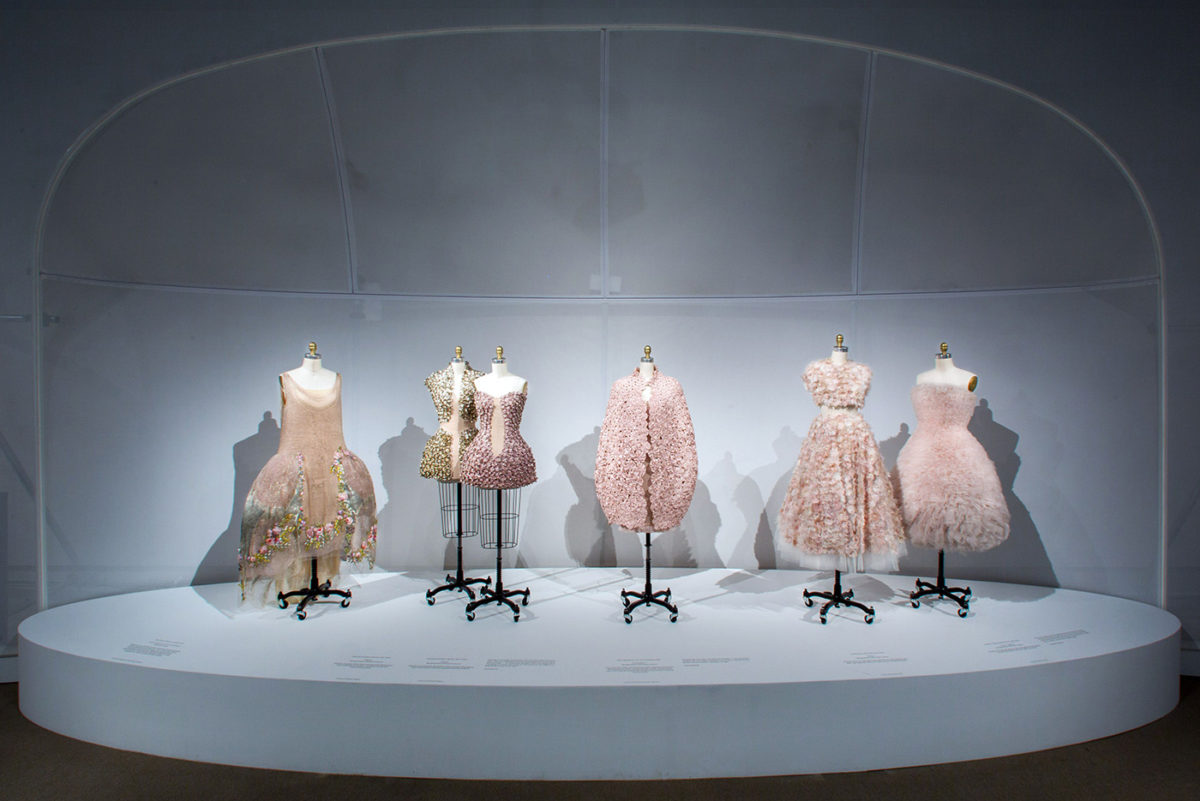
The Manus x Machina Exhibit “Fashion in the Age of Technology” opened to the public on May 5th at the Metropolitan Museum of Art until August 14, 2016. The collection is the Costume Institute’s spring 2016 exhibit located in the museum’s Robert Lehman Wing. The exhibit has over 170 garments donated from both new and renowned designers from all time periods. Dating back to the 20th century until today, the clothes represent how fashion has evolved not only through time but as well as through technique, culture and style.
As soon as you walk into the exhibit, a wedding gown with a dramatically embellished train by Karl Lagerfeld for the House of Chanel is displayed as the centerpiece of the circular layout. The train is completely covered in gold baroque designs with an oversized gold pendant and jewels on the front. The soft music playing in the background and the spotlights on each ensemble creates an intimate ambiance despite the large crowds. The layout of the exhibit was arranged as a series of rooms organized by themes such as embroidery, leatherwork, artificial flowers and pleating.

The designers were able to collaborate ready-to-wear styles with avant-garde concepts and designs. Manus meaning, “hand” and machina meaning “machine” describes the exhibit’s prominent emphasis on showing how handmade garments and machine made garments are both able to create timeless pieces. One memorable dress that was designed by Gareth Pugh was made out of black drinking straws. Another intricate piece was a fiery orange dress that resembled tree leaves made by Iris van Herpen. Using 3-D stereo lithography, which is the process of striking liquid polymer with laser beams, created the texturized ensemble.
There were multiple ensembles that were displayed in a series of how the garment looked flat versus on the mannequin. Japanese designer Issey Miyake for Miyake Design Studio had an ensemble from their autumn-winter 2010 collection that was made from a software created pattern that was heat pressed onto black fabric and heat-stamped with gold metallic foil. The first item in the display is how the garment looked alone, which was a completely flat and rectangle gold object resembling a piece of paper. The next part of the display was the garment half way opened which began to show the black and gold features of the dress and the final part of the series was the dress completely on the mannequin. The dress had heavy indentations from the ironing as well as a one shoulder long-sleeved design.
Many of those in the crowd were able to pinpoint time periods and how a designer’s collection was a reflection of such. For example, Japanese designer Comme Des Garcons had a leather flowered dress with studs from their 2015 fall-winter collection. Patrons discussed how the fabric choice was a reflection of the weather that would be typical of that time of year as well as the cut of the dress which was a simple A-line cut that would be a staple-layering piece for the winter months. Another example is a House of Balenciaga ivory draped gown. The dress was short and fitted with short sleeves from the 2003 spring-summer collection. Creative director at the time, Nicolas Ghesquiere, stated the draping and layering of the ensemble was inspired by Greek antiquity it was also mentioned that everything was done by hand and hand stitched onto the mannequin.
Each piece was complemented with a synopsis of the designer, the collection it came from and the materials used to create it. Majority of the outfits were accompanied by a quote from the designers themselves describing the process used to create the garment as well as insight to their appreciation for fashion. One of which from Karl Lagerfeld that was paired with the wedding ensemble, embodied the collection as a whole, “Perhaps it used to matter if a dress was handmade or machine-made, at least in haute couture, but now things are completely different… The digital revolution has changed the world.” The Manus x Machina exhibition created an excellent presentation of how tradition and technology can coincide through fashion.
Article by Nyaa Ferary for The Untitled Magazine


